Abstract
In this paper, the mechanical behavior of gradient nano-grained copper under uniaxial deformation was investigated using molecular dynamics simulations. The stress response was found to be different in the regions with different grain sizes, which was attributed to the different dislocation activities due to the dislocation-grain boundary synergies. The phenomenon of grain rotation was observed and a program was developed to accurately evaluate the grain rotation and explore its dependence on the grain size and the initial crystal orientation. It is found that all grains tend to rotate to the 30° orientation, consistent with the activation theory of the slip systems under the uniaxial deformation. The rotation magnitude is larger for larger grains, but the rotation rate is more diversely distributed for smaller grains, indicating more disturbance from grain boundary mechanisms such as the grain boundary sliding and the grain boundary diffusion for smaller grains. The effect of temperature on the grain rotation is also investigated, showing an increase of the dispersion of grain rotation distribution with the increase of temperature. This paper aims at providing insights into the synergistic deformation mechanisms from dislocations and grain boundaries accounting for the exceptional ductility of the gradient nano-grained metals.
1 Introduction
Grain rotation, referred to as the change of lattice orientation of grains, has received increasing attention since the ignition of research interests in nanocrystalline metals in 1990s. Although grain rotation is not treated as an important mechanism in coarse-grained metals, it is believed to play an important role in the plastic deformation of nanocrystalline metals in which the volume percentage of grain boundaries upsurges as the grain size decreases to nanometers [1,2,3]. Indeed, the phenomenon of grain rotation has been reported from a significant number of experiments and simulations in the nano-grained films and bulk materials. From the in situ tensile test of Pt thin films under a high-resolution TEM, Wang et al. [4] directly showed that when the grain size is below 6 nm, the plastic deformation mechanism transits from dislocation glide to grain rotation coordinated in multiple grains mediated by the climb of grain boundary (GB) dislocations. Li et al. [5] investigated the softening of nanocrystalline materials considering the grain rotation-based nonhomogeneous plastic deformation using a phase mixture model, in which the nanocrystalline materials were treated as composites consisting of grain interior and GB phases. Experiments and simulations [6,7,8] have indicated that as the grain size decreases from micrometer to a few nanometers, the dominating mechanism of plastic deformation evolves from full dislocation activity in large grains, to partial dislocation activity in smaller grains, and finally to GB-mediated mechanisms including grain creep, grain sliding, and grain rotation. It indicates that the Hall–Petch relation [1,9] that prevails for the conventional metal materials can no longer be applied for predicting the strength of the nanocrystalline metals [10]. The size dependence has been found for grain rotation. Some authors showed that grain rotation is much more evident in finer nanocrystals [11,12], while others reported a reversal size dependence of grain rotation [13]. Theoretical models were also established to calculate the grain rotation rate considering the mass diffusion and GB sliding, e.g., the efforts by Kim et al. [14,15], Harris et al. [16], and Wheeler [17].
Grain rotation is usually accompanied with other mechanical or thermal processes such as cracking, annealing, and grain growth. Cracking is a special mechanical scenario in which the grain rotation mechanism may take effect. It has been found that the deformation at the crack tip is accommodated by grain rotation in nanocrystalline metals. A number of in situ experiments [18] and theoretical modeling efforts [19,20] have been devoted to investigate the effect of grain rotation on the crack growth and blunting. For example, some authors (Li et al. [21,22], Zhang and Zhou [23]) showed that the nanograin rotation can significantly enhance the dislocation emission from the crack tip, leading to evident crack blunting in nanomaterials. Liu et al. [19] demonstrated that grain rotation-induced deformation mechanism can lead to an increase of the critical crack intensity factor. Grain rotation is also involved in the process of grain growth. The synergies among the grain rotation, the GB migration, the dislocation activities, and the grain growth have also been explored in a number of researches through the theoretical approach [20,24,25], the in situ TEM testing [26,27], the phase field simulations [28,29], etc. Several interesting phenomena and mechanisms have been reported. For example, Liu et al. [30] demonstrated that the cooperation between the nano-grain rotation and the GB migration could lead to the enhancement of the dislocation emission. Moldovan et al. [31,32] demonstrated that the grain coalescence induced by grain rotation leads to the power-law rate of grain growth with a universal scaling exponent. Farkas et al. [33] reported a linear kinetics for grain growth accompanied by grain rotation in the nanocrystalline Ni, which is different from the square root kinetics observed in the coarse-grained counterparts. Vuppuluri and Vedantam [34] deduced the average grain growth rate as R ∼ t 1/3 under the coupled mechanisms of GB migration and grain rotation coalescence. Besides cracking and grain growth, grain rotation can also be mediated by other mechanical or thermal processes. For example, Danilenko et al. [35] observed annealing-induced grain rotation in ultrafine-grained aluminum alloy from in situ TEM studies. Wang et al. [36] investigated the synergistic effects of rolling and annealing on the grain rotation and the resulted texture in nickel.
Most of the existing researches relating to grain rotation were carried out for the conventional metals with uniform grain size distribution. It is widely known that the conventional metals have long faced a dilemma of the strength-ductility tradeoff, i.e., an increase in strength leading to a decrease in ductility and vice versa [1,37,38]. Recently, a novel approach for overcoming this dilemma was proposed by Lu [39] and other researchers [40,41] who introduced gradient into the grain size distribution, referred to as gradient nano-grained (GNG) metals. The GNG metals have nonuniformly distributed grain size that increases gradually from a few nanometers near the surface to several micrometers in the interior. They possess several exceptional properties such as high strength, good strain hardening ability, satisfactory ductility, and excellent erosion resistance and can be economically produced through mechanical surface treatments such as mechanical surface attrition, frictional sliding, and high energy shot peening [42,43,44]. These advantages endow the GNG metals with a broad application potential and have attracted sustained research interests in investigating the underlined mechanisms behind their intriguing mechanical behaviors [45,46].
As reviewed by Chen et al. [47], grain rotation has been extensively studied through theoretical models, molecular dynamics simulations, and experimental investigations. However, few efforts have been devoted to grain rotation in the GNG metals. In our previous work [48], the grain rotation behavior during the uniaxial tension of nanocrystalline copper was investigated using the crystal plasticity finite element method (CPFEM). It was found that the grain rotation rate does not show any dependence on grain size. Noting that the CPFEM framework is based on the dislocation slip systems and does not incorporate the GB mechanisms, the CPFEM results may deviate from the reality. On the other hand, atomistic-based method such as molecular dynamics (MD) is a capable tool that can capture various mechanisms in the microstructure evolution of nanocrystalline metals [49,50,51]. In this paper, we carried out a thorough MD study to investigate the grain rotation behavior in gradient nanocrystalline copper, which is a widely investigated material in the literature [52,53,54]. This work is aimed at promoting the understanding of the synergistic deformation mechanisms of the nonuniform nano-grained materials.
2 Molecular dynamics modelling of GNG copper under uniaxial deformation
In real practice, the grain size of the GNG metals usually changes from several nanometers on the surface to hundreds of nanometers at a depth of 100 μm. Considering the forbidden computational cost in MD that a cube of just 1 μm size contains 80 billion atoms, it is not feasible to simulate a real GNG sample whose length is around 100 μm. Therefore, we adopted an economic scheme to save the computation cost by accelerating the gradient so that the grain size changes from several nanometers to tens of nanometers across a length of less than one micrometer. Besides, the sample possesses a quasi-three-dimensional configuration in which the thickness along the out-of-plane direction is very small and the shape of grains is actually columnar instead of equiaxed with the axes along the out-of-plane direction. Figure 1(a) shows one of the computational samples of GNG copper. The computational samples were created using the homemade codes. Firstly, a MATLAB program was developed to generate the gradient polycrystal topology using the Voronoi method. To incorporate the gradience in the grain size, the positions of the grain center seeds were adjusted according to a linear varied distribution along the depth direction. After the generation of the GNG topology, the polycrystals were filled with copper atoms arranged in face-centered cubic (FCC) lattices whose orientations vary from one grain to another. A FORTRAN program was developed to fill in the atoms. In this work, all the grains were orientated with their [111] crystal direction along the out-of-plane direction. The purpose of choosing the [111] orientation is that in that orientation, the three slip systems that could be possibly activated are
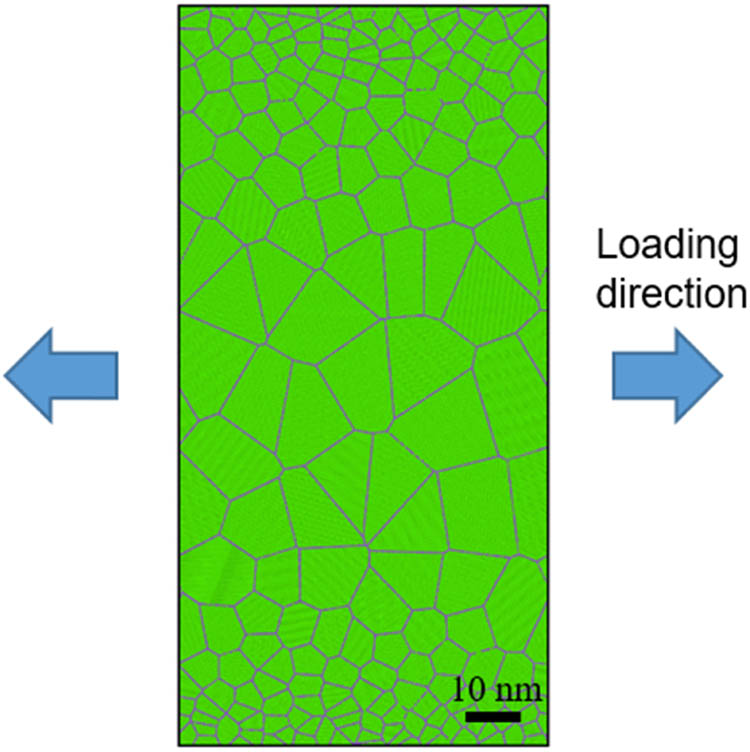
Topological configuration of GNG copper with gradient 3–25.
The simulations of uniaxial tensile deformation were carried out using the open source code LAMMPS. The embedded atom potential (EAM) was used to model the interaction between atoms. The period boundary condition was applied to all the sample boundaries except for the boundaries along the gradient direction. The dynamic equations were explicitly integrated using the velocity Verlet algorithm with a time step of 1 fs. The pressure along the out-of-plane direction was kept at 1 atm using the isothermal-isobaric (NPT) ensemble, while the pressure along the gradient direction was left uncontrolled at self-equilibrated state. Before loading application, the samples were relaxed at the temperature of 300 K for about 0.5 ns to iron out any possible energy-unfavorable defects. Then a uniaxial affine deformation was applied to the direction perpendicular to the grain size gradient at a constant strain rate of 0.5 × 109 s−1 with the temperature controlled at 300 K. This strain rate was chosen as a result of the balance of the computational cost and the computation fidelity. As a common limitation, molecular dynamic simulations suffer from the tiny integration time step and the resulting extremely high strain rate. Decreasing the strain rate would lead to a significant increase of the computational cost. A case simulation for the 50 nm grain-sized sample straining to 0.4 under the rate of 0.5 × 109 s−1 took 43.88 h using 256 nodes of Shanghai Supercomputer Center clusters (Intel Skylake Xeon, 2.6 GHz), which was close to the limit of computational cost we can afford. Although the adopted strain rate is still several orders of magnitude higher than the experimental strain rate of usually within 10−3 to 102, the simulations are believed to be able to reflect the dislocation-dominated grain rotation mechanisms. Besides, this strain rate was also adopted in the literature [10]. The maximum strain is unanimously set as 0.4 for all the samples so that adequate significant plastic deformation could take place.
To investigate the effect of grain size on the deformation behavior of the nanocrystalline copper, a series of uniform grained samples with different grain sizes were created (see Figure 2) and deformed under the same loading conditions. The results of the uniform grained samples were compared with those of the GNG sample to provide insights into the synergistic deformation mechanisms in GNG metals.

MD samples of the nanocrystalline copper with grain size of (a) 3 nm, (b) 12 nm, (c) 20 nm, and (d) 50 nm.
3 Results
3.1 Stress versus strain curves
Figure 3 compares the stress versus strain curves for the uniform grained samples with different grain sizes. It shows that the Young’s modulus is smaller for the smaller grain size of 3 nm. This can be attributed to the larger fraction of GB region for the 3 nm sample. As reported by the literature [55,56], the GB region is much less dense and thus has a smaller modulus compared with the grain interior region. Therefore, a smaller grain size corresponds to a smaller Young’s modulus. From Figure 3, the sample with smaller grain size also has a lower peak stress, while the tendency is opposite in terms of the plateau flow stress which is larger for the smaller grain size. In general, the stress–strain curve is less undulant for the smaller grain size. On the other hand, the strain hardening effect is more obvious for the larger grain size as can be seen by the steeper slope of the fitted lines of the plastic section of the stress–strain curve (see the dash lines fitted for the strain range 0.08–0.4). This stronger strain hardening can be attributed to the more evident dislocation activity in the larger grain size, as shown later in Section 3.2. The material parameters obtained from the stress–strain curves are listed in Table 1. The strain hardening modulus of the 50 nm grain size is three times as large as that of the 3 nm grain size.
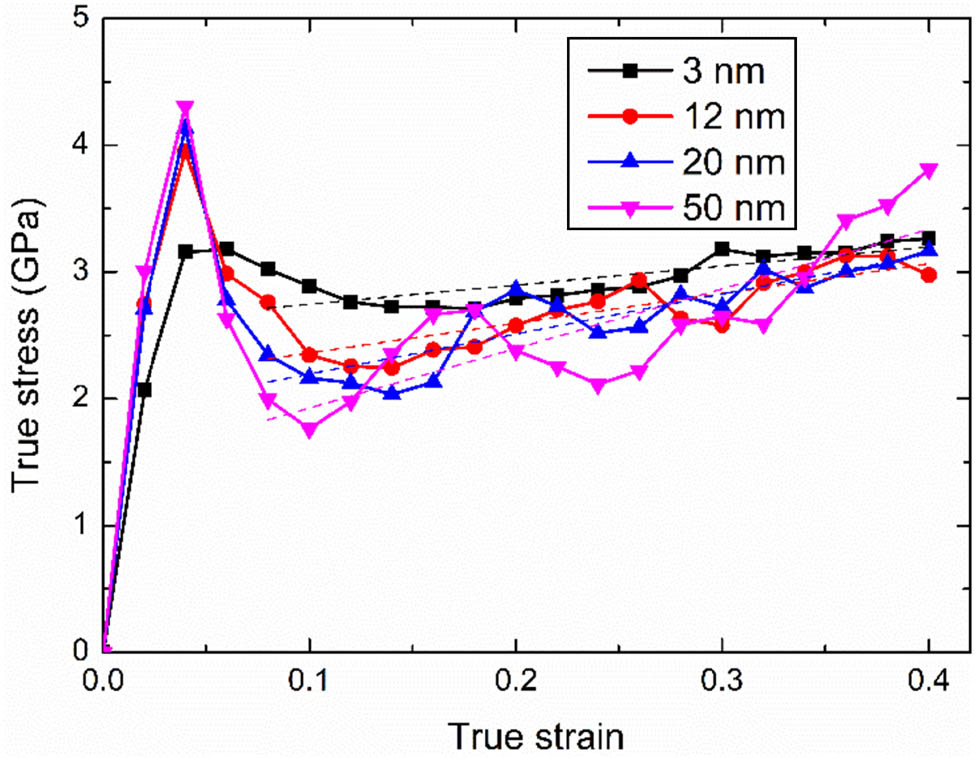
Stress versus strain curves for the MD samples with different grain sizes, with the dashed lines being the linear fitting for the strain range 0.08–0.4.
Material parameters from the stress–strain curves for different grain sizes
| Grain size (nm) | Young’s modulus (GPa) | Yield stress (GPa) | Strain hardening modulus (GPa) | R 2 of curve fitting |
|---|---|---|---|---|
| 3 | 103.4 | 3.16 | 1.51 | 0.78 |
| 12 | 137.4 | 3.95 | 2.35 | 0.80 |
| 20 | 135.6 | 4.13 | 3.16 | 0.88 |
| 50 | 150.3 | 4.31 | 4.70 | 0.83 |
3.2 Dislocation activities
Figure 4 shows the snapshots of the samples during the uniaxial deformation at strains 0.1, 0.2, and 0.4. In these graphs, the green lines indicate the Shockley partial dislocations, the red lines indicate the stair-rod dislocations, the atoms-colored blue are at the GBs, and all other atoms are not displayed for clarity. To make the dislocation lines more clearly seen, only part of the samples are shown. Evident dislocation activities can be seen from all these snapshots. However, some differences still exist between the small grain (3 nm) sample and the large grain (50 nm) sample in terms of the dislocation-GB synergy and the grain coalescence/partition. In the small grain (3 nm) sample, the dislocations are relatively nonuniformly distributed, i.e., the dislocations are abundant in some grains, while scarce in others. On the other hand, abundant dislocation activities can be seen in nearly all the grains in the large grain (50 nm) sample. In the small grain sample, the complete extended dislocations are seldom displayed. The dislocations displayed are usually leading partials (see solid arrows) which are nucleated from the GBs, slip across the whole grains, and disappear in the opposite GBs. On the other hand, the complete extended dislocations (see hollow arrows) can be clearly seen in the large grains, with the leading partials, the trailing partials, and the stacking faults in between. In addition, dislocations in the large grains can also be nucleated from the grain interior besides the GBs. These phenomena indicate that the impediment effects of the GBs on the dislocation activities are more evident in the small grain sample. Another interesting phenomenon is that in the small grain sample the grain coalescence process is evident, while in the large grain sample the grain partition is the dominant process. This can be attributed to the abundant dislocation activities in the large grains that the dislocations have large probability to intersect with each other, leading to the generation of sub-GB structures.
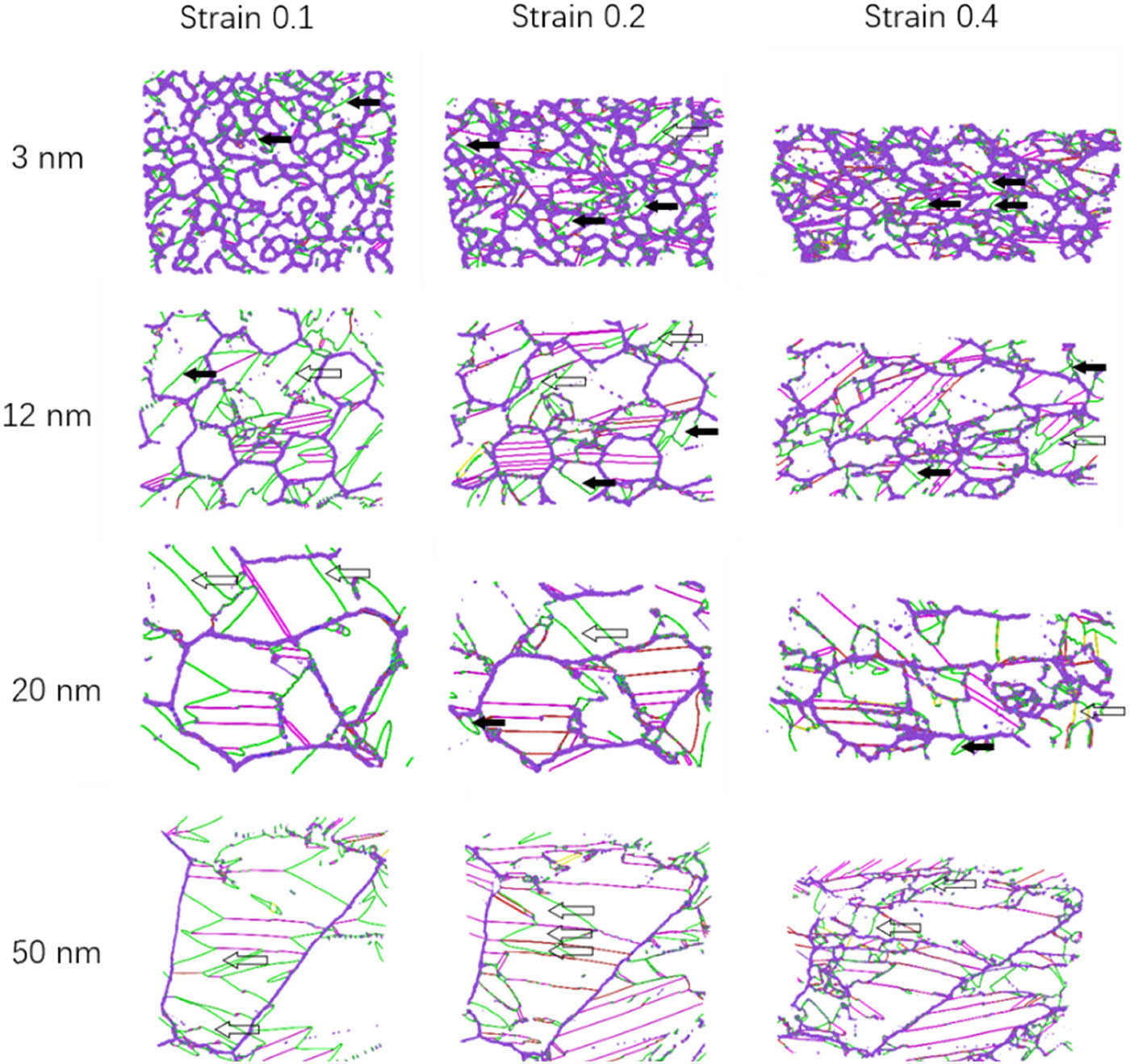
Snapshots of the MD samples with different grain sizes during the uniaxial straining.
The effect of the grain size on the dislocation activity can be more clearly seen from the variations of Shockley dislocation density and the fraction of hexagonal close-packed (HCP) atoms during the deformation as shown in Figure 5a and b, respectively. From Figure 5a, the density of Shockley dislocation is larger for a smaller grain size. This can be explained by the larger fraction of GBs acting as the dislocation sources in the small grain sample. Nevertheless, the fraction of HCP atoms is less for the sample with smaller grain size, as shown in Figure 5b. Noting that HCP atoms are usually the atoms at the stacking faults, the proportion of HCP can be taken as a measure of the intensity of dislocation activity. It indicates that the larger grains are more favorable medium for the motion of dislocations. From Figure 5b, it also shows that the HCP proportion reaches a saturated value at a certain strain and will decrease as the strain further increases. This decrease of HCP proportion can be attributed to the absorption of Shockley partial dislocations by the GBs when the extended dislocations slide across the whole grain.
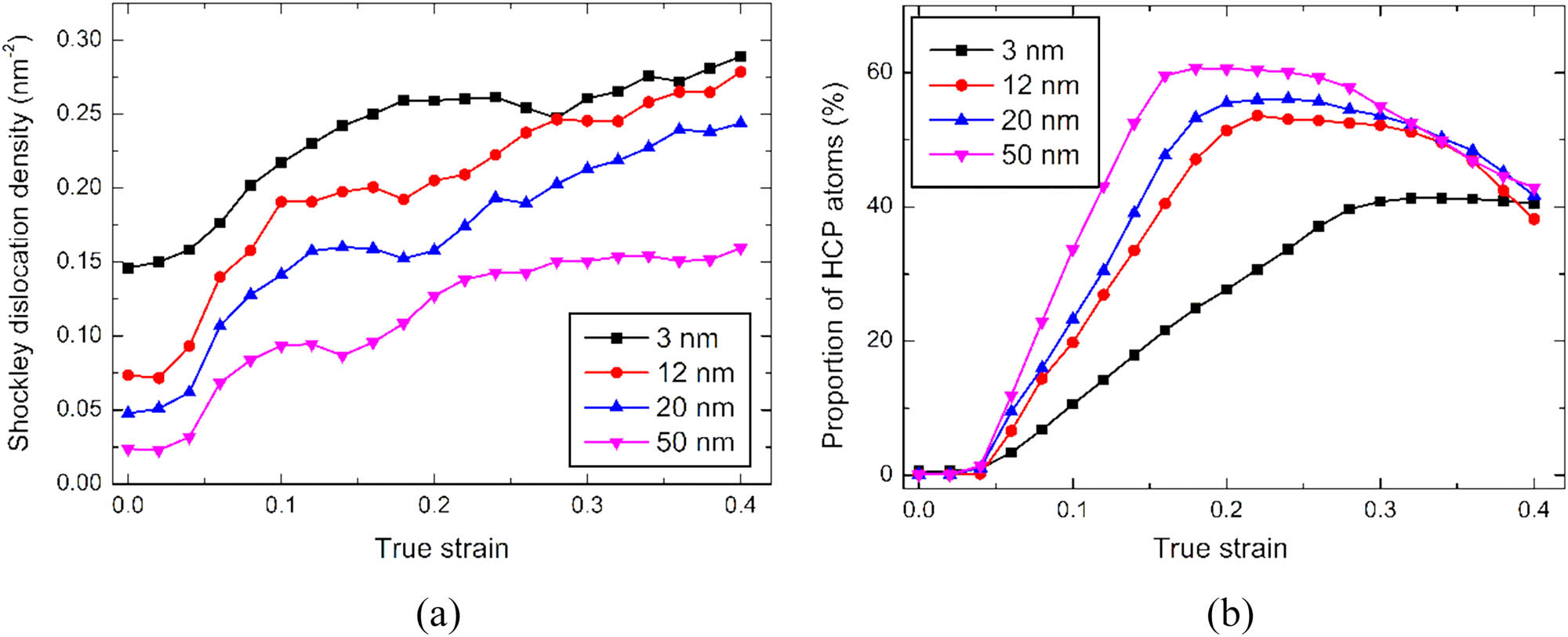
Variations of (a) Shockley dislocation density and (b) the proportion of HCP atoms during the uniaxial deformation.
3.3 Grain rotations
In our previous work, the phenomenon of grain rotations was observed in the deformation simulations of GNG metals using the CPFEM. It was found that the magnitude of grain rotation strongly depends on the initial lattice orientation of the grain, but does not depend on the grain size. This conclusion may not hold true for real situations since the CPFEM framework only incorporates the dislocation slip mechanisms and cannot reflect the GB mechanisms such as GB mass diffusion and GB sliding. In this work, the phenomenon of grain rotation is investigated from our MD simulations. For this purpose, a program was developed to track the change of orientation for each grain based on the statistics on the relative positions of all the atoms in that grain. The variation of the orientation angle with the strain is shown in Figure 6. Here, the orientation angle is defined as the angle between the
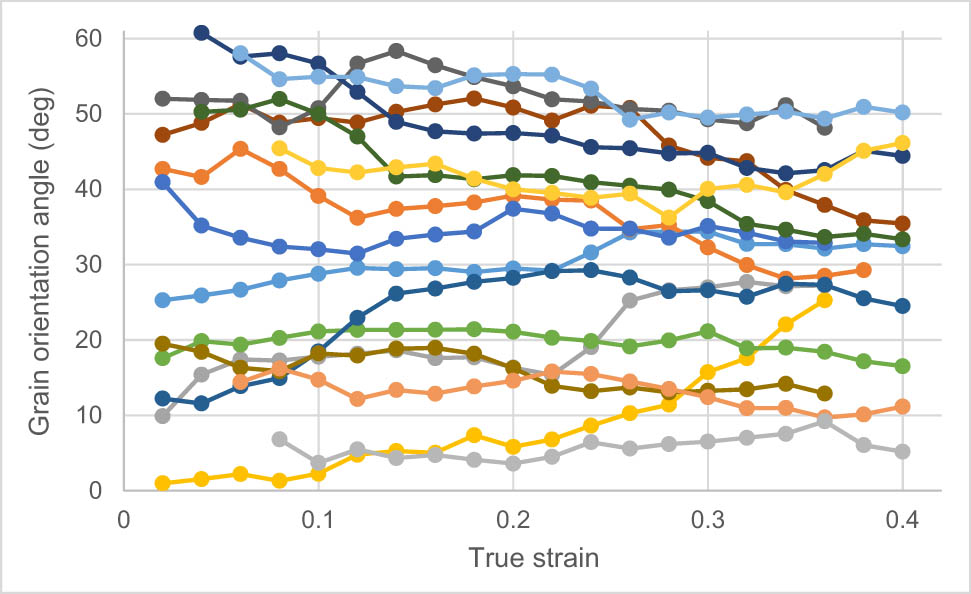
Variation of the orientation angle of each grain with the strain, with different colors assigned just to differentiate the curves of different grains.
This phenomenon is consistent with the theoretical model of the grain rotation under the uniaxial deformation due to the activation of different slip systems, as demonstrated by Hosford [57]. The slip system will be activated once the resolved shear stress on it, measured by the Schmid factor, exceeds that on other slip systems. As the plastic deformation goes on, the grain tends to rotate to the orientation that the slip direction of the activated slip system is parallel to the tensile axis. The Schmid factor μ is calculated as in equation (1)
where, λ is the angle between the slip direction and the tensile axis, and ϕ is the angle between the normal of slip plane and the tensile axis. For the configuration adopted in this work that the [111] crystal direction is always along the out-of-plane direction, the possible slip systems that can be activated are the 9 slip systems, i.e.,
| Slip plane |
|
|---|---|
|
|
|
|
|
|
|
|
|
|
|
|
|
|
|
|
|
|
| Slip direction |
|
|---|---|
|
|
|
|
|
|
|
|
|
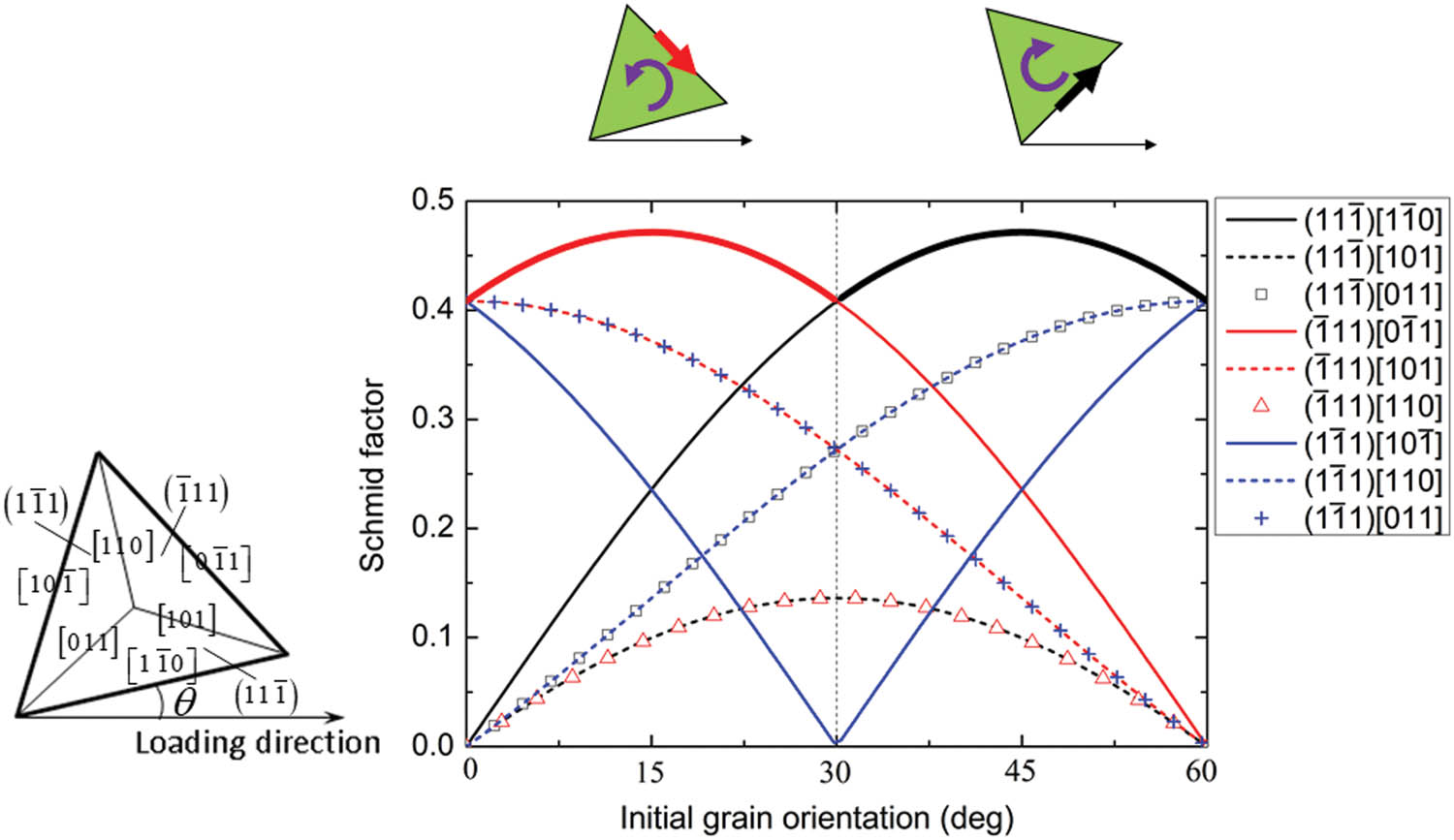
Dependence of the Schmid factor on the initial grain orientation for the 9 slip systems that have nonzero Schmid factor values.
When the initial grain orientation is between 0° and 30°, the slip system
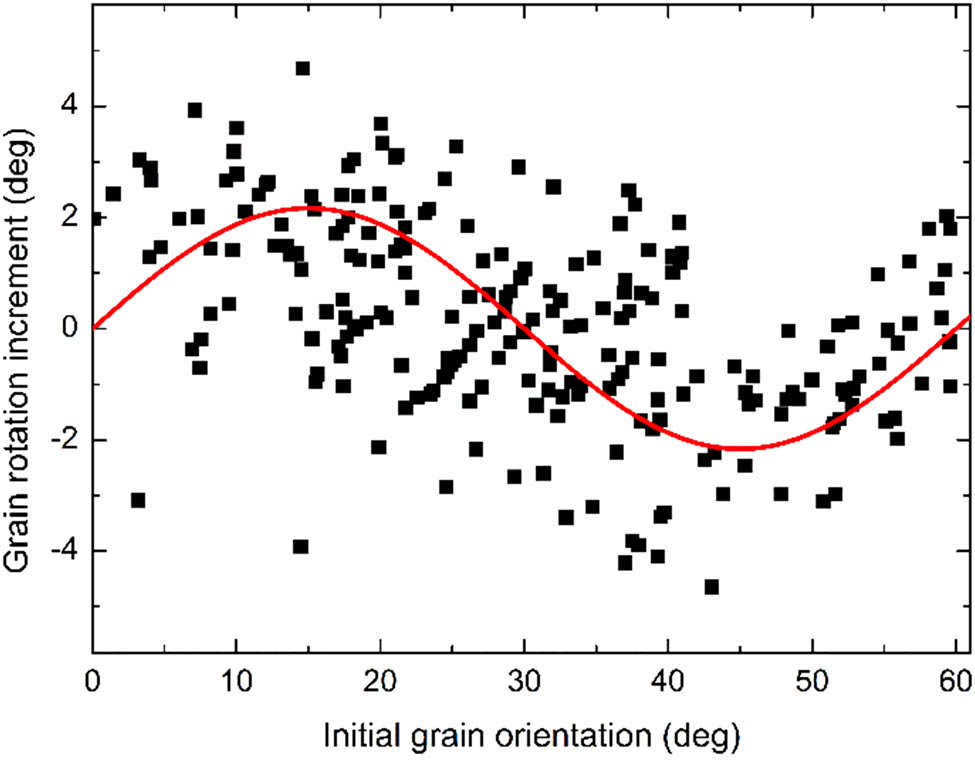
Dependence of grain rotation on the initial grain orientation, with the dots for the rotation results of each grain, and the curve for the data fitting.
The results of the grain rotation Δθ versus the initial grain orientation θ 0 can be fitted by a sinusoidal function as equation (2).
The amplitude of the fitted curve A represents the rate of the grain rotation, while the standard deviation of the fitting D represents the diversity of the grain rotation distribution. For the specific sample shown in Figure 8, A and D are 2.16° and 1.35°, respectively. Figure 9 shows the fitted amplitude varying with the strain. It shows that larger grains rotate faster compared with the smaller grains, owing to the more evident dislocation activities in the larger grains. This can lead to faster convergence of the grain orientation of larger grains. Indeed, if we plot the standard deviation of the grain orientation from its stable value 30° versus the strain in Figure 10, the slope of the curve is larger for the larger grain.
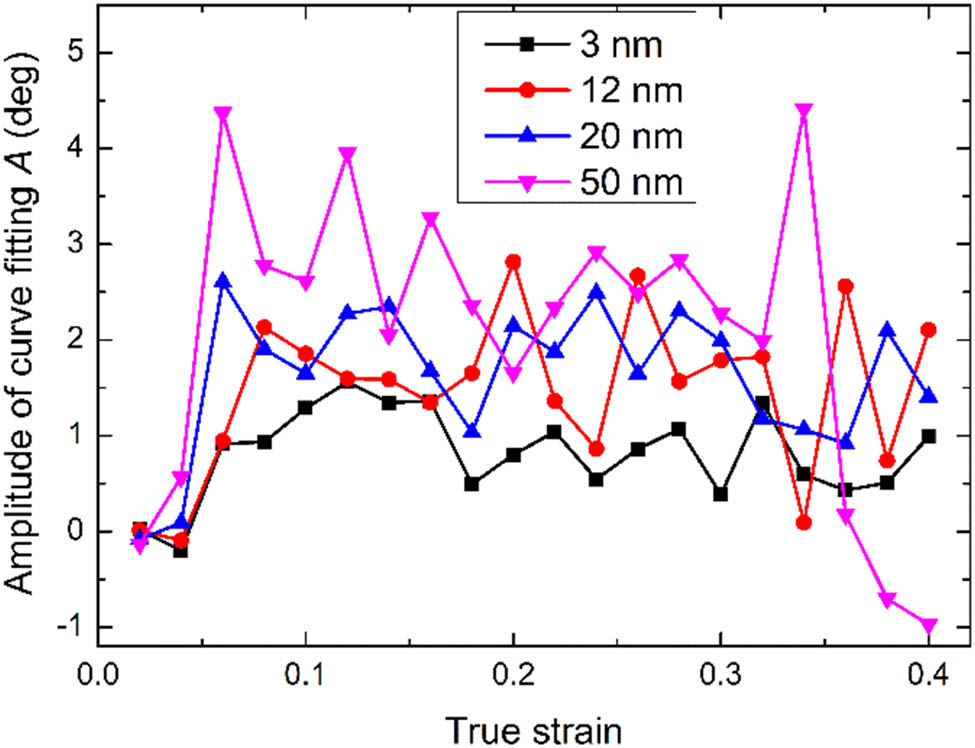
Variation of the amplitude of grain rotation increment with the strain.
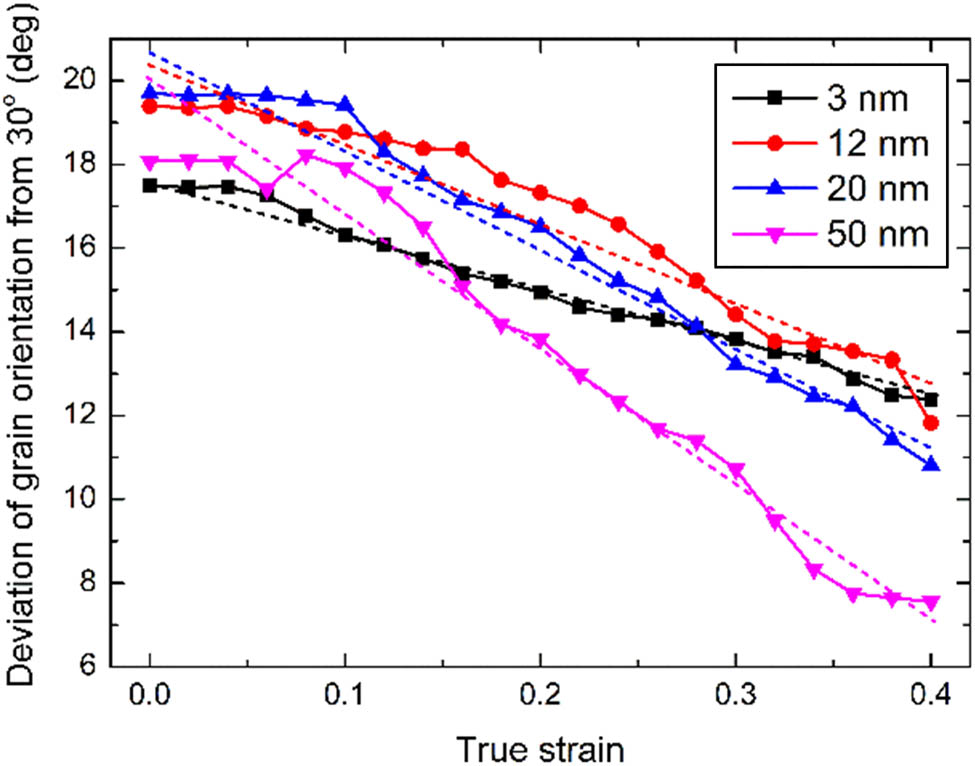
Variation of the deviation of the grain orientation from 30° versus the strain.
On the other hand, Figure 11 shows that the standard deviation of the grain rotation rate is larger for the smaller grains, especially for the elastic deformation range, indicating the larger diversity of the grain rotation distribution for the smaller grains. This phenomenon may be attributed to the effects of GB mechanisms such as the GB sliding and the GB diffusion on the grain rotation. As the grain size decreases, the GB mechanisms play a more important role, leading to the larger proportion of the GB-induced grain rotation driven by the GB energy and the external work [2]. As demonstrated in the literature [2], the GB-induced grain rotation mechanism is not a cause of texture, but can be taken as a disturbance to the sinusoidal type grain rotation distribution shown in Figure 8. It is noted from Figure 11 that as the strain reaches the plastic stage, the dependence of the standard deviation of grain rotation on the grain size becomes opaque, which is different from the elastic stage. This could be attributed to the dominance of the dislocation slip-induced grain rotation mechanism which favors the large grains in the plastic stage. After reaching the plastic stage, the abundant dislocation activities give rise to the significant slip-induced grain rotation, whose fluctuation surpasses the contribution of the GB-induced grain rotation. Therefore, the smaller grains can no longer exhibit a larger fluctuation of grain rotation than the larger grains.
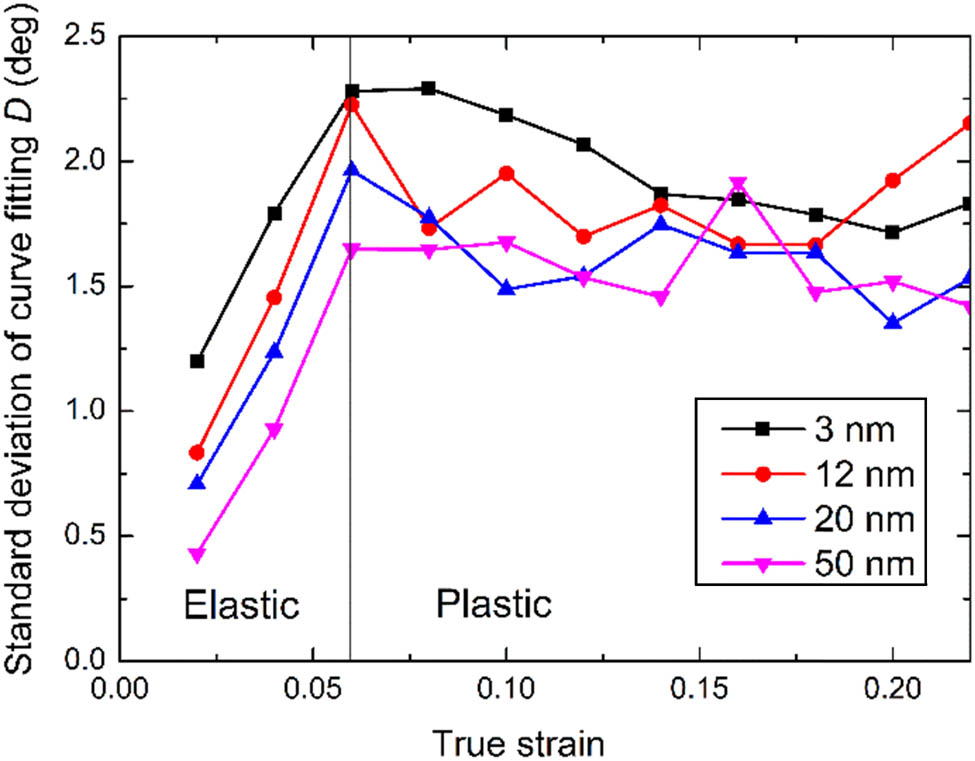
Variation of the standard deviation of grain rotation increment with the strain.
As a summary of the effects of grain size on the grain rotation, Table 4 lists the amplitude A and the standard deviation D for fitting the grain rotation distribution at 0.06 strain, as well as the slope k of the grain orientation deviation from 30° versus the strain (see Figure 10) for different grain sizes. It is noted that the investigated grain size range is from 3 to 50 nm. Within that range, the results show a monotonic increase of grain rotation amplitude and a monotonic decrease of the dispersion of the grain rotation distribution as the grain size increases. Whether these trends are suitable for grain sizes outside of this range is remained for future study.
Grain rotation results for different grain sizes
| Grain size (nm) | A (deg) | D (deg) | k (deg) |
|---|---|---|---|
| 3 | 0.92 | 2.28 | 13.39 |
| 12 | 0.95 | 2.23 | 18.97 |
| 20 | 2.61 | 1.96 | 24.30 |
| 50 | 4.37 | 1.65 | 31.08 |
3.4 Effect of temperature
We further investigated the effect of temperature on the stress–strain curve and the grain rotation behavior. For this purpose, additional simulations were carried out for straining the sample of 12 nm grain size at the temperature of 10 K. The stress–strain curve is shown in Figure 12. It is seen that the yield stress and the plateau stress at 10 K temperature are higher than those at 300 K temperature, indicating a harder mechanical response at a lower temperature. Similar to the grain rotation behavior at 300 K, the dependence of grain rotation on the initial grain orientation at 10 K can also be fitted by a sinusoidal curve. The fitting results are shown in Figure 13. Figure 13(a) shows that the fitted amplitude is not sensitive to the temperature, while Figure 13(b) shows that the standard deviation of the fitting is larger at 300 K than that at 10 K. This can be possibly attributed to the stronger contribution of GB-induced grain rotation at the increased temperature, leading to a larger dispersion in the grain rotation distribution at 300 K compared to that at 10 K. On the other hand, the magnitude of grain rotation induced by the dislocation slip is not much sensitive to the temperature change.
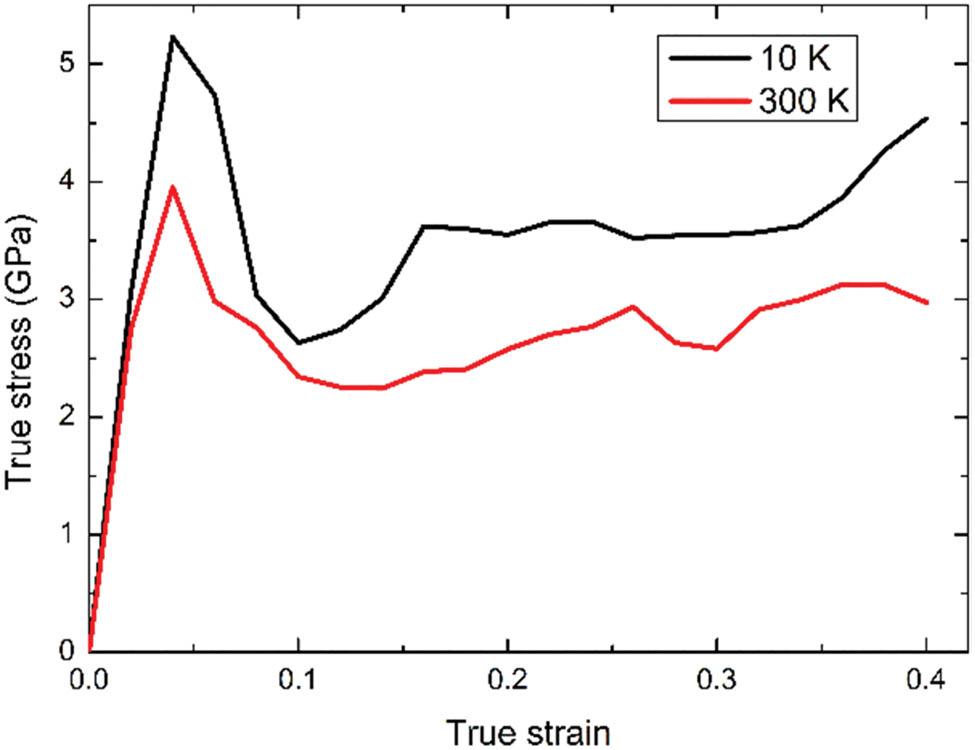
Temperature effect on the stress–strain curve.
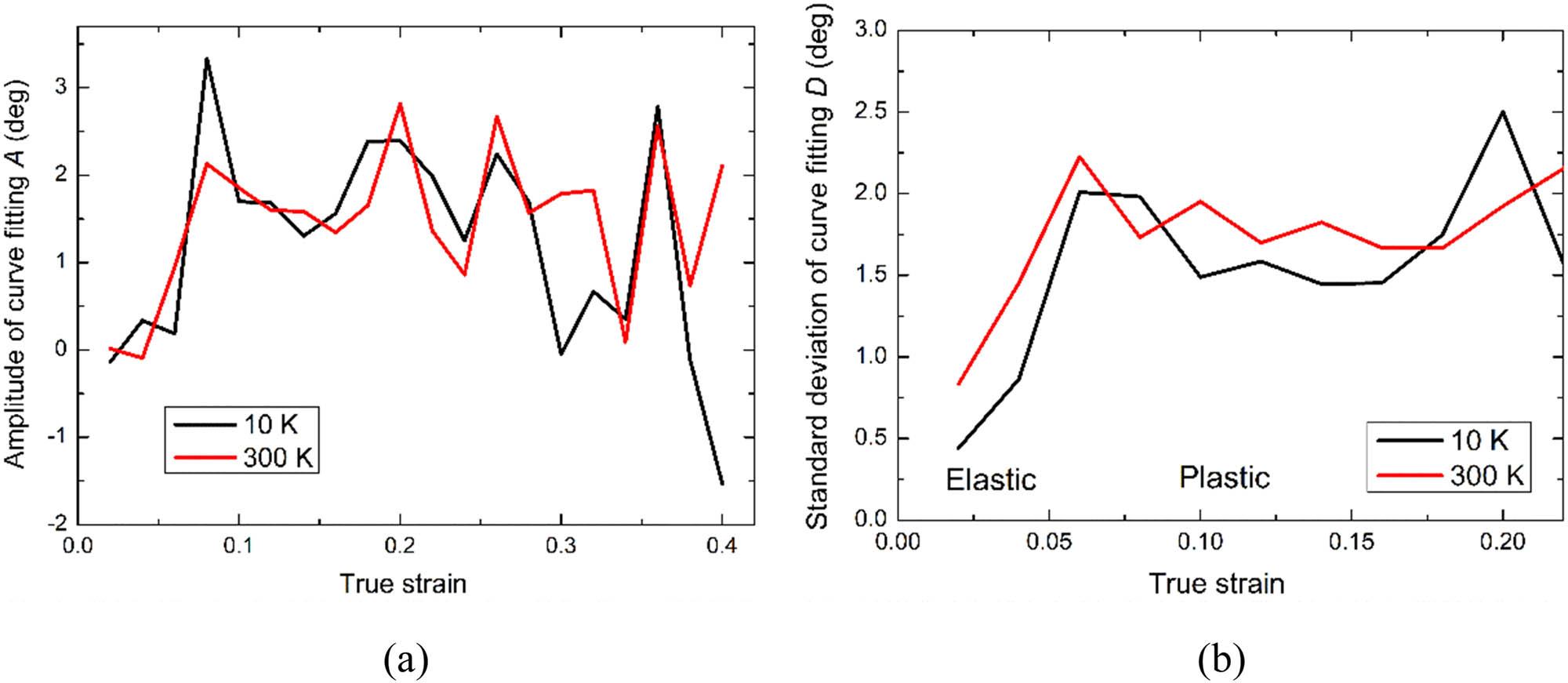
Temperature effect on (a) the amplitude and (b) the standard deviation of the curve fitting for the initial orientation dependence of grain rotation rate.
4 Conclusions and discussions
In this paper, grain rotations induced by the deformation in the GNG copper was explored using MD simulations. First, the computational samples of GNG copper were created using Voronoi method. A systematic study was carried out to investigate the stress–strain curves, the dislocation activities, and the grain rotation through simulations of different grain-sized samples. The synergistic effects of the dislocation mechanisms and the grain boundary mechanisms on the grain rotation were evaluated. The following conclusions can be drawn.
Among the investigated grain size from 3 to 50 nm, the 3 nm grain size corresponds to the smallest Young’s modulus, but the largest plateau flow stress. On the other side, the 50 nm grain size corresponds to the strongest strain hardening capability.
The larger grains are more favorable for the motion of dislocations, leading to larger fraction of HCP atoms during the deformation.
Grain rotation was observed and its rate was found to depend on the initial crystal orientation. It makes the orientations of all grains tend to 30°, leading to the texture during the uniaxial tensile deformation.
The grain rotation magnitude is larger for larger grains, but the rotation rate is more diversely distributed for smaller grains, indicating more disturbance from the GB mechanisms such as the GB sliding and the GB diffusion for smaller grains.
The grain rotation magnitude at 10 K temperature is comparable to that at 300 K, while the rotation rate is less diversely distributed at the lower temperature.
Although we did not investigate other nanocrystalline metals, we believe that some of the conclusions obtained from the simulations of copper in this paper are applicable to other FCC metals. For example, dominated by the dislocation slip mechanism, the grain rotation magnitude is larger for larger grains, while the rotation rate is more diversely distributed for smaller grains due to the influence of the GB mechanisms. However, whether these conclusions are applicable for other types of metals are difficult to be judged. Besides, the current study is based on the conventional nanocrystalline metals, and the conclusions may not be suitable for nano-twinned crystals. The complex interactions between the twin boundaries and the dislocations [58,59] will possibly make the grain rotation behavior different from that without twin boundaries. These topics are remained for future study.
-
Author contributions: All authors have accepted responsibility for the entire content of this manuscript and approved its submission.
-
Research funding: The authors acknowledge the support from National Natural Science Foundation of China (11772231), Shanghai Science and Technology Innovation Plan (20ZR1462700), and Shanghai Supercomputer Center.
-
Conflict of interest: The authors state no conflict of interest.
References
[1] Meyers MA, Mishra A, Benson DJ. Mechanical properties of nanocrystalline materials. Prog Mater Sci. 2006;51(4):427–556.10.1016/j.pmatsci.2005.08.003Search in Google Scholar
[2] Yang F, Yang W. Kinetics and size effect of grain rotations in nanocrystals with rounded triple junctions. Scr Mater. 2009;61(9):919–22.10.1016/j.scriptamat.2009.07.039Search in Google Scholar
[3] Chandel VS, Wang G, Talha M. Advances in modelling and analysis of nano structures: a review. Nanotech Rev. 2020;9(1):230–58.10.1515/ntrev-2020-0020Search in Google Scholar
[4] Wang L, Teng J, Liu P, Hirata A, Ma E, Zhang Z, et al. Grain rotation mediated by grain boundary dislocations in nanocrystalline platinum. Nat Commun. 2014;5:4402.10.1038/ncomms5402Search in Google Scholar PubMed PubMed Central
[5] Li X, Zhou J, Zhu R, Liu Y, Jiang H. Grain rotation dependent non-homogeneous deformation behavior in nanocrystalline materials. Mater Sci Eng A. 2010;527(21–22):5677–85.10.1016/j.msea.2010.05.054Search in Google Scholar
[6] Shu X, Kong D, Lu Y, Long H, Sun S, Sha X, et al. Size effect on the deformation mechanisms of nanocrystalline platinum thin films. Sci Rep. 2017;7:13264.10.1038/s41598-017-13615-6Search in Google Scholar PubMed PubMed Central
[7] Yang F, Yang W. Crack growth versus blunting in nanocrystalline metals with extremely small grain size. J Mech Phys Solids. 2009;57(2):305–24.10.1016/j.jmps.2008.10.011Search in Google Scholar
[8] Ni H, Wang L, Wang Z, Zhu J. Grain orientation induced softening in electrodeposited gradient nanostructured nickel during cold rolling deformation. Rev Adv Mater Sci. 2020;59:144–50.10.1515/rams-2020-0105Search in Google Scholar
[9] Wu Q, Miao W, Zhang Y, Gao H, Hui D. Mechanical properties of nanomaterials: a review. Nanotech Rev. 2020;9:259–73.10.1515/ntrev-2020-0021Search in Google Scholar
[10] Ruestes CJ, Bertolino G, Ruda M, Farkas D, Bringa EM. Grain size effects in the deformation of [0001] textured nanocrystalline Zr. Scr Mater. 2014;71:9–12.10.1016/j.scriptamat.2013.09.010Search in Google Scholar
[11] Zhou X, Tamura N, Mi Z, Zhang L, Ke F, Chen B. Measuring grain rotation at the nanoscale. High Pressure Res. 2017;37(3):287–95.10.1080/08957959.2017.1334775Search in Google Scholar
[12] Chen B, Lutker K, Lei J, Yan J, Yang S, Mao H-K. Detecting grain rotation at the nanoscale. PNAS. 2014;111(9):3350–3.10.1073/pnas.1324184111Search in Google Scholar PubMed PubMed Central
[13] Zhou X, Tamura N, Mi Z, Lei J, Yan J, Zhang L, et al. Reversal in the size dependence of grain rotation. Phys Rev Lett. 2017;118(9):096101.10.1103/PhysRevLett.118.096101Search in Google Scholar PubMed
[14] Kim B-N, Hiraga K, Morita K. Viscous grain-boundary sliding and grain rotation accommodated by grain-boundary diffusion. Acta Mater. 2005;53(6):1791–8.10.1016/j.actamat.2004.12.028Search in Google Scholar
[15] Kim B-N, Hiraga K, Morita K, Yoshida H, Ahn B-W. Viscous grain-boundary sliding with rotating particles or grains. Acta Mater. 2009;57(19):5730–8.10.1016/j.actamat.2009.08.001Search in Google Scholar
[16] Harris KE, Singh VV, King AH. Grain rotation in thin films of gold. Acta mater. 1998;46(8):2623–33.10.1016/S1359-6454(97)00467-9Search in Google Scholar
[17] Wheeler J. Anisotropic rheology during grain boundary diffusion creep and its relation to grain rotation, grain boundary sliding and superplasticity. Philos Mag. 2010;90(21):2841–64.10.1080/14786431003636097Search in Google Scholar
[18] Vetterick G, Leff AC, Marshall M, Baldwin JK, Misra A, Hattar K, et al. Direct observation of a coincident dislocation- and grain boundary-mediated deformation in nanocrystalline iron. Mater Sci Eng A. 2018;709:339–48.10.1016/j.msea.2017.09.020Search in Google Scholar
[19] Liu Y, Zhou J, Shen TD, Hui D. Grain rotation dependent fracture toughness of nanocrystalline materials. Mater Sci Eng A. 2011;528(25–26):7684–7.10.1016/j.msea.2011.06.035Search in Google Scholar
[20] Ovid’Ko IA, Sheinerman AG. Nanoscale rotational deformation near crack tips in nanocrystalline solids. J Phys D: Appl Phys. 2012;45(33):335301.10.1088/0022-3727/45/33/335301Search in Google Scholar
[21] Li J, Chen S, Weng GJ. Significantly enhanced crack blunting by nanograin rotation in nanocrystalline materials. Scr Mater. 2018;151:19–23.10.1016/j.scriptamat.2018.03.030Search in Google Scholar
[22] Li J, Chen S, Weng GJ, Liu C. Stress-assisted grain-rotation-induced dislocation emission from grain boundaries in nanocrystalline face-centered-cubic metals. Philos Mag Lett. 2019;99(12):466–78.10.1080/09500839.2019.1703054Search in Google Scholar
[23] Zhang F, Zhou J. Grain sizes effect on crack blunting considering nano-grain rotation and dislocation-GB interactions. Mech Mater. 2019;129:214–21.10.1016/j.mechmat.2018.11.016Search in Google Scholar
[24] Li J, Soh AK, Wu X. On nanograin rotation by dislocation climb in nanocrystalline materials. Scr Mater. 2014;78–79:5–8.10.1016/j.scriptamat.2013.12.021Search in Google Scholar
[25] Li J, Qin F, Lu W, Weng GJ. A synergetic grain growth mechanism uniting nanograin rotation and grain boundary migration in nanocrystalline materials. Results Phys. 2019;14:102381.10.1016/j.rinp.2019.102381Search in Google Scholar
[26] Mompiou F, Legros M. Quantitative grain growth and rotation probed by in situ TEM straining and orientation mapping in small grained Al thin films. Scr Mater. 2015;99:5–8.10.1016/j.scriptamat.2014.11.004Search in Google Scholar
[27] Ossai CI, Raghavan N. Nanostructure and nanomaterial characterization, growth mechanisms, and applications. Nanotech Rev. 2018;7(2):209–31.10.1515/ntrev-2017-0156Search in Google Scholar
[28] Vuppuluri A. Theory and simulation of microstructure evolution due to simultaneous grain boundary migration and grain rotation with misorientation dependent energy and mobility. Mater Sci Eng A. 2018;713:118–24.10.1016/j.msea.2017.12.031Search in Google Scholar
[29] Trautt ZT, Mishin Y. Capillary-driven grain boundary motion and grain rotation in a tricrystal: A molecular dynamics study. Acta Mater. 2014;65:19–31.10.1016/j.actamat.2013.11.059Search in Google Scholar
[30] Liu C, Lu W, Weng GJ, Li J. A cooperative nano-grain rotation and grain-boundary migration mechanism for enhanced dislocation emission and tensile ductility in nanocrystalline materials. Mater Sci Eng A. 2019;756:284–90.10.1016/j.msea.2019.04.055Search in Google Scholar
[31] Moldovan D, Yamakov V, Wolf D, Phillpot SR. Scaling behavior of grain-rotation-induced grain growth. Phys Rev Lett. 2002;89(20):206101.10.1103/PhysRevLett.89.206101Search in Google Scholar PubMed
[32] Moldovan D, Wolf D, Phillpot SR. Theory of diffusion-accommodated grain rotation in columnar polycrystalline microstructures. Acta Mater. 2001;49(17):3521–32.10.1016/S1359-6454(01)00240-3Search in Google Scholar
[33] Farkas D, Mohanty S, Monk J. Linear grain growth kinetics and rotation in nanocrystalline Ni. Phys Rev Lett. 2007;98(16):165502.10.1103/PhysRevLett.98.165502Search in Google Scholar PubMed
[34] Vuppuluri A, Vedantam S. Grain growth rate for coupled grain boundary migration and grain rotation in nanocrystalline materials. Philos Mag Lett. 2016;96(9):339–46.10.1080/09500839.2016.1220683Search in Google Scholar
[35] Danilenko VN, Bachurin DV, Nazarov AA. Annealing-induced grain rotation in ultrafine-grained aluminum allay. Rev Adv Mater Sci. 2018;55(1):69–77.10.1515/rams-2018-0029Search in Google Scholar
[36] Wang L, Chen X, Luo T, Ni H, Mei L, Ren P, et al. Effect of cross cold rolling and annealing on microstructure and texture in pure nickel. Rev Adv Mater Sci. 2020;59:252–63.10.1515/rams-2020-0016Search in Google Scholar
[37] Ritchie RobertO. The conflicts between strength and toughness. Nat Mater. 2011;10(11):817–22.10.1038/nmat3115Search in Google Scholar PubMed
[38] Wei Y, Li Y, Zhu L, Liu Y, Lei X, Wang G, et al. Evading the strength–ductility trade-off dilemma in steel through gradient hierarchical nanotwins. Nat Commun. 2014;5:3580.10.1038/ncomms4580Search in Google Scholar PubMed PubMed Central
[39] Lu K. Making strong nanomaterials ductile with gradients. Science. 2014;345(6203):1455–6.10.1126/science.1255940Search in Google Scholar PubMed
[40] Fang TH, Li WL, Tao NR, Lu K. Revealing extraordinary intrinsic tensile plasticity in gradient nano-grained copper. Science. 2011;331(6024):1587–90.10.1126/science.1200177Search in Google Scholar PubMed
[41] Fan J, Zhu L, Lu J, Fu T, Chen A. Theory of designing the gradient microstructured metals for overcoming strength-ductility trade-off. Scr Mater. 2020;184:41–5.10.1016/j.scriptamat.2020.03.045Search in Google Scholar
[42] Deng SQ, Godfrey A, Liu W, Zhang CL. Microstructural evolution of pure copper subjected to friction sliding deformation at room temperature. Mater Sci Eng A. 2015;639:448–55.10.1016/j.msea.2015.05.017Search in Google Scholar
[43] Yang L, Tao NR, Lu K, Lu L. Enhanced fatigue resistance of Cu with a gradient nanograined surface layer. Scr Mater. 2013;68(10):801–4.10.1016/j.scriptamat.2013.01.031Search in Google Scholar
[44] Muhamad SS, Ghani JA, Haron CHC, Yazid H. Cryogenic milling and formation of nanostructured machined surface of AISI 4340. Nanotech Rev. 2020;9:1104–17.10.1515/ntrev-2020-0086Search in Google Scholar
[45] Fan JT, Yan YM. Gradient microstructure with martensitic transformation for developing a large-size metallic alloy with enhanced mechanical properties. Mater Des. 2018;143:20–6.10.1016/j.matdes.2018.01.055Search in Google Scholar
[46] Fan J, Jiang M. Strain hardenability of a gradient metallic alloy under high-strain-rate compressive loading. Mater Des. 2019;170:107695.10.1016/j.matdes.2019.107695Search in Google Scholar
[47] Chen B, Zhu L, Xin Y, Lei J. Grain rotation in plastic deformation. Quantum Beam Sci. 2019;3(3):17.10.3390/qubs3030017Search in Google Scholar
[48] Li Z, Yang F. Grain rotations during uniaxial deformation of gradient nano-grained metals using crystal plasticity finite element simulations. Extreme Mech Lett. 2017;16:41–8.10.1016/j.eml.2017.09.003Search in Google Scholar
[49] Cao P. The strongest size in gradient nanograined metals. Nano Lett. 2020;20(2):1440–6.10.1021/acs.nanolett.9b05202Search in Google Scholar PubMed
[50] Li X, Wei Y, Lu L, Lu K, Gao H. Dislocation nucleation governed softening and maximum strength in nano-twinned metals. Nature. 2010;464(7290):877–80.10.1038/nature08929Search in Google Scholar PubMed
[51] Zhou H, Qu S, Yang W. An atomistic investigation of structural evolution in metallic glass matrix composites. Int J Plast. 2013;44:147–60.10.1016/j.ijplas.2013.01.002Search in Google Scholar
[52] Guo X, Song K, Xu W, Li G, Zhang Z. Effect of TiB2 particle size on the material transfer behaviour of Cu-TiB2 composites. Mater Sci Tech. 2020;26(5):1–10.10.1080/02670836.2020.1821964Search in Google Scholar
[53] Long F, Guo X, Song K, Jia S, Yakubov V, Li S, et al. Synergistic strengthening effect of carbon nanotubes (CNTs) and titanium diboride (TiB2) microparticles on mechanical properties of copper matrix composites. J Mater Res Tech. 2020;9(4):7989–8000.10.1016/j.jmrt.2020.05.036Search in Google Scholar
[54] Feng J, Song K, Liang S, Guo X, Jiang Y. Electrical wear of TiB2 particle-reinforced Cu and Cu–Cr composites prepared by vacuum arc melting. Vacuum. 2020;175:109295.10.1016/j.vacuum.2020.109295Search in Google Scholar
[55] Farkas D. Fracture resistance of nanocrystalline Ni. Metall Mater Trans A. 2007;38:2168–73.10.1007/s11661-007-9180-zSearch in Google Scholar
[56] Giallonardoab JD, Erba U, Austa KT, Palumbo G. The influence of grain size and texture on the Young’s modulus of nanocrystalline nickel and nickel–iron alloys. Philos Mag. 2011;91:4594–605.10.1080/14786435.2011.615350Search in Google Scholar
[57] Hosford WF. Mechanical behavior of materials. Cambridge: Cambridge University Press; 2005.10.1017/CBO9780511810930Search in Google Scholar
[58] Qu S, Zhou H. Hardening by twin boundary during nanoindentation in nanocrystals. Nanotechnology. 2010;21:335704.10.1088/0957-4484/21/33/335704Search in Google Scholar PubMed
[59] Zhou H, Qu S. The effect of nanoscale twin boundaries on fracture toughness in nanocrystalline Ni. Nanotechnology. 2010;21:035706.10.1088/0957-4484/21/3/035706Search in Google Scholar PubMed
© 2021 Jiarui Zhang et al., published by De Gruyter
This work is licensed under the Creative Commons Attribution 4.0 International License.
Articles in the same Issue
- Research Articles
- Improved impedance matching by multi-componential metal-hybridized rGO toward high performance of microwave absorption
- Pure-silk fibroin hydrogel with stable aligned micropattern toward peripheral nerve regeneration
- Effective ion pathways and 3D conductive carbon networks in bentonite host enable stable and high-rate lithium–sulfur batteries
- Fabrication and characterization of 3D-printed gellan gum/starch composite scaffold for Schwann cells growth
- Synergistic strengthening mechanism of copper matrix composite reinforced with nano-Al2O3 particles and micro-SiC whiskers
- Deformation mechanisms and plasticity of ultrafine-grained Al under complex stress state revealed by digital image correlation technique
- On the deformation-induced grain rotations in gradient nano-grained copper based on molecular dynamics simulations
- Removal of sulfate from aqueous solution using Mg–Al nano-layered double hydroxides synthesized under different dual solvent systems
- Microwave-assisted sol–gel synthesis of TiO2-mixed metal oxide nanocatalyst for degradation of organic pollutant
- Electrophoretic deposition of graphene on basalt fiber for composite applications
- Polyphenylene sulfide-coated wrench composites by nanopinning effect
- Thermal conductivity and thermoelectric properties in 3D macroscopic pure carbon nanotube materials
- An effective thermal conductivity and thermomechanical homogenization scheme for a multiscale Nb3Sn filaments
- Friction stir spot welding of AA5052 with additional carbon fiber-reinforced polymer composite interlayer
- Improvement of long-term cycling performance of high-nickel cathode materials by ZnO coating
- Quantum effects of gas flow in nanochannels
- An approach to effectively improve the interfacial bonding of nano-perfused composites by in situ growth of CNTs
- Effects of nano-modified polymer cement-based materials on the bending behavior of repaired concrete beams
- Effects of the combined usage of nanomaterials and steel fibres on the workability, compressive strength, and microstructure of ultra-high performance concrete
- One-pot solvothermal synthesis and characterization of highly stable nickel nanoparticles
- Comparative study on mechanisms for improving mechanical properties and microstructure of cement paste modified by different types of nanomaterials
- Effect of in situ graphene-doped nano-CeO2 on microstructure and electrical contact properties of Cu30Cr10W contacts
- The experimental study of CFRP interlayer of dissimilar joint AA7075-T651/Ti-6Al-4V alloys by friction stir spot welding on mechanical and microstructural properties
- Vibration analysis of a sandwich cylindrical shell in hygrothermal environment
- Water barrier and mechanical properties of sugar palm crystalline nanocellulose reinforced thermoplastic sugar palm starch (TPS)/poly(lactic acid) (PLA) blend bionanocomposites
- Strong quadratic acousto-optic coupling in 1D multilayer phoxonic crystal cavity
- Three-dimensional shape analysis of peripapillary retinal pigment epithelium-basement membrane layer based on OCT radial images
- Solvent regulation synthesis of single-component white emission carbon quantum dots for white light-emitting diodes
- Xanthate-modified nanoTiO2 as a novel vulcanization accelerator enhancing mechanical and antibacterial properties of natural rubber
- Effect of steel fiber on impact resistance and durability of concrete containing nano-SiO2
- Ultrasound-enhanced biosynthesis of uniform ZnO nanorice using Swietenia macrophylla seed extract and its in vitro anticancer activity
- Temperature dependence of hardness prediction for high-temperature structural ceramics and their composites
- Study on the frequency of acoustic emission signal during crystal growth of salicylic acid
- Controllable modification of helical carbon nanotubes for high-performance microwave absorption
- Role of dry ozonization of basalt fibers on interfacial properties and fracture toughness of epoxy matrix composites
- Nanosystem’s density functional theory study of the chlorine adsorption on the Fe(100) surface
- A rapid nanobiosensing platform based on herceptin-conjugated graphene for ultrasensitive detection of circulating tumor cells in early breast cancer
- Improving flexural strength of UHPC with sustainably synthesized graphene oxide
- The role of graphene/graphene oxide in cement hydration
- Structural characterization of microcrystalline and nanocrystalline cellulose from Ananas comosus L. leaves: Cytocompatibility and molecular docking studies
- Evaluation of the nanostructure of calcium silicate hydrate based on atomic force microscopy-infrared spectroscopy experiments
- Combined effects of nano-silica and silica fume on the mechanical behavior of recycled aggregate concrete
- Safety study of malapposition of the bio-corrodible nitrided iron stent in vivo
- Triethanolamine interface modification of crystallized ZnO nanospheres enabling fast photocatalytic hazard-free treatment of Cr(vi) ions
- Novel electrodes for precise and accurate droplet dispensing and splitting in digital microfluidics
- Construction of Chi(Zn/BMP2)/HA composite coating on AZ31B magnesium alloy surface to improve the corrosion resistance and biocompatibility
- Experimental and multiscale numerical investigations on low-velocity impact responses of syntactic foam composites reinforced with modified MWCNTs
- Comprehensive performance analysis and optimal design of smart light pole for cooperative vehicle infrastructure system
- Room temperature growth of ZnO with highly active exposed facets for photocatalytic application
- Influences of poling temperature and elongation ratio on PVDF-HFP piezoelectric films
- Large strain hardening of magnesium containing in situ nanoparticles
- Super stable water-based magnetic fluid as a dual-mode contrast agent
- Photocatalytic activity of biogenic zinc oxide nanoparticles: In vitro antimicrobial, biocompatibility, and molecular docking studies
- Hygrothermal environment effect on the critical buckling load of FGP microbeams with initial curvature integrated by CNT-reinforced skins considering the influence of thickness stretching
- Thermal aging behavior characteristics of asphalt binder modified by nano-stabilizer based on DSR and AFM
- Building effective core/shell polymer nanoparticles for epoxy composite toughening based on Hansen solubility parameters
- Structural characterization and nanoscale strain field analysis of α/β interface layer of a near α titanium alloy
- Optimization of thermal and hydrophobic properties of GO-doped epoxy nanocomposite coatings
- The properties of nano-CaCO3/nano-ZnO/SBR composite-modified asphalt
- Three-dimensional metallic carbon allotropes with superhardness
- Physical stability and rheological behavior of Pickering emulsions stabilized by protein–polysaccharide hybrid nanoconjugates
- Optimization of volume fraction and microstructure evolution during thermal deformation of nano-SiCp/Al–7Si composites
- Phase analysis and corrosion behavior of brazing Cu/Al dissimilar metal joint with BAl88Si filler metal
- High-efficiency nano polishing of steel materials
- On the rheological properties of multi-walled carbon nano-polyvinylpyrrolidone/silicon-based shear thickening fluid
- Fabrication of Ag/ZnO hollow nanospheres and cubic TiO2/ZnO heterojunction photocatalysts for RhB degradation
- Fabrication and properties of PLA/nano-HA composite scaffolds with balanced mechanical properties and biological functions for bone tissue engineering application
- Investigation of the early-age performance and microstructure of nano-C–S–H blended cement-based materials
- Reduced graphene oxide coating on basalt fabric using electrophoretic deposition and its role in the mechanical and tribological performance of epoxy/basalt fiber composites
- Effect of nano-silica as cementitious materials-reducing admixtures on the workability, mechanical properties and durability of concrete
- Machine-learning-assisted microstructure–property linkages of carbon nanotube-reinforced aluminum matrix nanocomposites produced by laser powder bed fusion
- Physical, thermal, and mechanical properties of highly porous polylactic acid/cellulose nanofibre scaffolds prepared by salt leaching technique
- A comparative study on characterizations and synthesis of pure lead sulfide (PbS) and Ag-doped PbS for photovoltaic applications
- Clean preparation of washable antibacterial polyester fibers by high temperature and high pressure hydrothermal self-assembly
- Al 5251-based hybrid nanocomposite by FSP reinforced with graphene nanoplates and boron nitride nanoparticles: Microstructure, wear, and mechanical characterization
- Interlaminar fracture toughness properties of hybrid glass fiber-reinforced composite interlayered with carbon nanotube using electrospray deposition
- Microstructure and life prediction model of steel slag concrete under freezing-thawing environment
- Synthesis of biogenic silver nanoparticles from the seed coat waste of pistachio (Pistacia vera) and their effect on the growth of eggplant
- Study on adaptability of rheological index of nano-PUA-modified asphalt based on geometric parameters of parallel plate
- Preparation and adsorption properties of nano-graphene oxide/tourmaline composites
- A study on interfacial behaviors of epoxy/graphene oxide derived from pitch-based graphite fibers
- Multiresponsive carboxylated graphene oxide-grafted aptamer as a multifunctional nanocarrier for targeted delivery of chemotherapeutics and bioactive compounds in cancer therapy
- Piezoresistive/piezoelectric intrinsic sensing properties of carbon nanotube cement-based smart composite and its electromechanical sensing mechanisms: A review
- Smart stimuli-responsive biofunctionalized niosomal nanocarriers for programmed release of bioactive compounds into cancer cells in vitro and in vivo
- Photoremediation of methylene blue by biosynthesized ZnO/Fe3O4 nanocomposites using Callistemon viminalis leaves aqueous extract: A comparative study
- Study of gold nanoparticles’ preparation through ultrasonic spray pyrolysis and lyophilisation for possible use as markers in LFIA tests
- Review Articles
- Advance on the dispersion treatment of graphene oxide and the graphene oxide modified cement-based materials
- Development of ionic liquid-based electroactive polymer composites using nanotechnology
- Nanostructured multifunctional electrocatalysts for efficient energy conversion systems: Recent perspectives
- Recent advances on the fabrication methods of nanocomposite yarn-based strain sensor
- Review on nanocomposites based on aerospace applications
- Overview of nanocellulose as additives in paper processing and paper products
- The frontiers of functionalized graphene-based nanocomposites as chemical sensors
- Material advancement in tissue-engineered nerve conduit
- Carbon nanostructure-based superhydrophobic surfaces and coatings
- Functionalized graphene-based nanocomposites for smart optoelectronic applications
- Interfacial technology for enhancement in steel fiber reinforced cementitious composite from nano to macroscale
- Metal nanoparticles and biomaterials: The multipronged approach for potential diabetic wound therapy
- Review on resistive switching mechanisms of bio-organic thin film for non-volatile memory application
- Nanotechnology-enabled biomedical engineering: Current trends, future scopes, and perspectives
- Research progress on key problems of nanomaterials-modified geopolymer concrete
- Smart stimuli-responsive nanocarriers for the cancer therapy – nanomedicine
- An overview of methods for production and detection of silver nanoparticles, with emphasis on their fate and toxicological effects on human, soil, and aquatic environment
- Effects of chemical modification and nanotechnology on wood properties
- Mechanisms, influencing factors, and applications of electrohydrodynamic jet printing
- Application of antiviral materials in textiles: A review
- Phase transformation and strengthening mechanisms of nanostructured high-entropy alloys
- Research progress on individual effect of graphene oxide in cement-based materials and its synergistic effect with other nanomaterials
- Catalytic defense against fungal pathogens using nanozymes
- A mini-review of three-dimensional network topological structure nanocomposites: Preparation and mechanical properties
- Mechanical properties and structural health monitoring performance of carbon nanotube-modified FRP composites: A review
- Nano-scale delivery: A comprehensive review of nano-structured devices, preparative techniques, site-specificity designs, biomedical applications, commercial products, and references to safety, cellular uptake, and organ toxicity
- Effects of alloying, heat treatment and nanoreinforcement on mechanical properties and damping performances of Cu–Al-based alloys: A review
- Recent progress in the synthesis and applications of vertically aligned carbon nanotube materials
- Thermal conductivity and dynamic viscosity of mono and hybrid organic- and synthetic-based nanofluids: A critical review
- Recent advances in waste-recycled nanomaterials for biomedical applications: Waste-to-wealth
- Layup sequence and interfacial bonding of additively manufactured polymeric composite: A brief review
- Quantum dots synthetization and future prospect applications
- Approved and marketed nanoparticles for disease targeting and applications in COVID-19
- Strategies for improving rechargeable lithium-ion batteries: From active materials to CO2 emissions
Articles in the same Issue
- Research Articles
- Improved impedance matching by multi-componential metal-hybridized rGO toward high performance of microwave absorption
- Pure-silk fibroin hydrogel with stable aligned micropattern toward peripheral nerve regeneration
- Effective ion pathways and 3D conductive carbon networks in bentonite host enable stable and high-rate lithium–sulfur batteries
- Fabrication and characterization of 3D-printed gellan gum/starch composite scaffold for Schwann cells growth
- Synergistic strengthening mechanism of copper matrix composite reinforced with nano-Al2O3 particles and micro-SiC whiskers
- Deformation mechanisms and plasticity of ultrafine-grained Al under complex stress state revealed by digital image correlation technique
- On the deformation-induced grain rotations in gradient nano-grained copper based on molecular dynamics simulations
- Removal of sulfate from aqueous solution using Mg–Al nano-layered double hydroxides synthesized under different dual solvent systems
- Microwave-assisted sol–gel synthesis of TiO2-mixed metal oxide nanocatalyst for degradation of organic pollutant
- Electrophoretic deposition of graphene on basalt fiber for composite applications
- Polyphenylene sulfide-coated wrench composites by nanopinning effect
- Thermal conductivity and thermoelectric properties in 3D macroscopic pure carbon nanotube materials
- An effective thermal conductivity and thermomechanical homogenization scheme for a multiscale Nb3Sn filaments
- Friction stir spot welding of AA5052 with additional carbon fiber-reinforced polymer composite interlayer
- Improvement of long-term cycling performance of high-nickel cathode materials by ZnO coating
- Quantum effects of gas flow in nanochannels
- An approach to effectively improve the interfacial bonding of nano-perfused composites by in situ growth of CNTs
- Effects of nano-modified polymer cement-based materials on the bending behavior of repaired concrete beams
- Effects of the combined usage of nanomaterials and steel fibres on the workability, compressive strength, and microstructure of ultra-high performance concrete
- One-pot solvothermal synthesis and characterization of highly stable nickel nanoparticles
- Comparative study on mechanisms for improving mechanical properties and microstructure of cement paste modified by different types of nanomaterials
- Effect of in situ graphene-doped nano-CeO2 on microstructure and electrical contact properties of Cu30Cr10W contacts
- The experimental study of CFRP interlayer of dissimilar joint AA7075-T651/Ti-6Al-4V alloys by friction stir spot welding on mechanical and microstructural properties
- Vibration analysis of a sandwich cylindrical shell in hygrothermal environment
- Water barrier and mechanical properties of sugar palm crystalline nanocellulose reinforced thermoplastic sugar palm starch (TPS)/poly(lactic acid) (PLA) blend bionanocomposites
- Strong quadratic acousto-optic coupling in 1D multilayer phoxonic crystal cavity
- Three-dimensional shape analysis of peripapillary retinal pigment epithelium-basement membrane layer based on OCT radial images
- Solvent regulation synthesis of single-component white emission carbon quantum dots for white light-emitting diodes
- Xanthate-modified nanoTiO2 as a novel vulcanization accelerator enhancing mechanical and antibacterial properties of natural rubber
- Effect of steel fiber on impact resistance and durability of concrete containing nano-SiO2
- Ultrasound-enhanced biosynthesis of uniform ZnO nanorice using Swietenia macrophylla seed extract and its in vitro anticancer activity
- Temperature dependence of hardness prediction for high-temperature structural ceramics and their composites
- Study on the frequency of acoustic emission signal during crystal growth of salicylic acid
- Controllable modification of helical carbon nanotubes for high-performance microwave absorption
- Role of dry ozonization of basalt fibers on interfacial properties and fracture toughness of epoxy matrix composites
- Nanosystem’s density functional theory study of the chlorine adsorption on the Fe(100) surface
- A rapid nanobiosensing platform based on herceptin-conjugated graphene for ultrasensitive detection of circulating tumor cells in early breast cancer
- Improving flexural strength of UHPC with sustainably synthesized graphene oxide
- The role of graphene/graphene oxide in cement hydration
- Structural characterization of microcrystalline and nanocrystalline cellulose from Ananas comosus L. leaves: Cytocompatibility and molecular docking studies
- Evaluation of the nanostructure of calcium silicate hydrate based on atomic force microscopy-infrared spectroscopy experiments
- Combined effects of nano-silica and silica fume on the mechanical behavior of recycled aggregate concrete
- Safety study of malapposition of the bio-corrodible nitrided iron stent in vivo
- Triethanolamine interface modification of crystallized ZnO nanospheres enabling fast photocatalytic hazard-free treatment of Cr(vi) ions
- Novel electrodes for precise and accurate droplet dispensing and splitting in digital microfluidics
- Construction of Chi(Zn/BMP2)/HA composite coating on AZ31B magnesium alloy surface to improve the corrosion resistance and biocompatibility
- Experimental and multiscale numerical investigations on low-velocity impact responses of syntactic foam composites reinforced with modified MWCNTs
- Comprehensive performance analysis and optimal design of smart light pole for cooperative vehicle infrastructure system
- Room temperature growth of ZnO with highly active exposed facets for photocatalytic application
- Influences of poling temperature and elongation ratio on PVDF-HFP piezoelectric films
- Large strain hardening of magnesium containing in situ nanoparticles
- Super stable water-based magnetic fluid as a dual-mode contrast agent
- Photocatalytic activity of biogenic zinc oxide nanoparticles: In vitro antimicrobial, biocompatibility, and molecular docking studies
- Hygrothermal environment effect on the critical buckling load of FGP microbeams with initial curvature integrated by CNT-reinforced skins considering the influence of thickness stretching
- Thermal aging behavior characteristics of asphalt binder modified by nano-stabilizer based on DSR and AFM
- Building effective core/shell polymer nanoparticles for epoxy composite toughening based on Hansen solubility parameters
- Structural characterization and nanoscale strain field analysis of α/β interface layer of a near α titanium alloy
- Optimization of thermal and hydrophobic properties of GO-doped epoxy nanocomposite coatings
- The properties of nano-CaCO3/nano-ZnO/SBR composite-modified asphalt
- Three-dimensional metallic carbon allotropes with superhardness
- Physical stability and rheological behavior of Pickering emulsions stabilized by protein–polysaccharide hybrid nanoconjugates
- Optimization of volume fraction and microstructure evolution during thermal deformation of nano-SiCp/Al–7Si composites
- Phase analysis and corrosion behavior of brazing Cu/Al dissimilar metal joint with BAl88Si filler metal
- High-efficiency nano polishing of steel materials
- On the rheological properties of multi-walled carbon nano-polyvinylpyrrolidone/silicon-based shear thickening fluid
- Fabrication of Ag/ZnO hollow nanospheres and cubic TiO2/ZnO heterojunction photocatalysts for RhB degradation
- Fabrication and properties of PLA/nano-HA composite scaffolds with balanced mechanical properties and biological functions for bone tissue engineering application
- Investigation of the early-age performance and microstructure of nano-C–S–H blended cement-based materials
- Reduced graphene oxide coating on basalt fabric using electrophoretic deposition and its role in the mechanical and tribological performance of epoxy/basalt fiber composites
- Effect of nano-silica as cementitious materials-reducing admixtures on the workability, mechanical properties and durability of concrete
- Machine-learning-assisted microstructure–property linkages of carbon nanotube-reinforced aluminum matrix nanocomposites produced by laser powder bed fusion
- Physical, thermal, and mechanical properties of highly porous polylactic acid/cellulose nanofibre scaffolds prepared by salt leaching technique
- A comparative study on characterizations and synthesis of pure lead sulfide (PbS) and Ag-doped PbS for photovoltaic applications
- Clean preparation of washable antibacterial polyester fibers by high temperature and high pressure hydrothermal self-assembly
- Al 5251-based hybrid nanocomposite by FSP reinforced with graphene nanoplates and boron nitride nanoparticles: Microstructure, wear, and mechanical characterization
- Interlaminar fracture toughness properties of hybrid glass fiber-reinforced composite interlayered with carbon nanotube using electrospray deposition
- Microstructure and life prediction model of steel slag concrete under freezing-thawing environment
- Synthesis of biogenic silver nanoparticles from the seed coat waste of pistachio (Pistacia vera) and their effect on the growth of eggplant
- Study on adaptability of rheological index of nano-PUA-modified asphalt based on geometric parameters of parallel plate
- Preparation and adsorption properties of nano-graphene oxide/tourmaline composites
- A study on interfacial behaviors of epoxy/graphene oxide derived from pitch-based graphite fibers
- Multiresponsive carboxylated graphene oxide-grafted aptamer as a multifunctional nanocarrier for targeted delivery of chemotherapeutics and bioactive compounds in cancer therapy
- Piezoresistive/piezoelectric intrinsic sensing properties of carbon nanotube cement-based smart composite and its electromechanical sensing mechanisms: A review
- Smart stimuli-responsive biofunctionalized niosomal nanocarriers for programmed release of bioactive compounds into cancer cells in vitro and in vivo
- Photoremediation of methylene blue by biosynthesized ZnO/Fe3O4 nanocomposites using Callistemon viminalis leaves aqueous extract: A comparative study
- Study of gold nanoparticles’ preparation through ultrasonic spray pyrolysis and lyophilisation for possible use as markers in LFIA tests
- Review Articles
- Advance on the dispersion treatment of graphene oxide and the graphene oxide modified cement-based materials
- Development of ionic liquid-based electroactive polymer composites using nanotechnology
- Nanostructured multifunctional electrocatalysts for efficient energy conversion systems: Recent perspectives
- Recent advances on the fabrication methods of nanocomposite yarn-based strain sensor
- Review on nanocomposites based on aerospace applications
- Overview of nanocellulose as additives in paper processing and paper products
- The frontiers of functionalized graphene-based nanocomposites as chemical sensors
- Material advancement in tissue-engineered nerve conduit
- Carbon nanostructure-based superhydrophobic surfaces and coatings
- Functionalized graphene-based nanocomposites for smart optoelectronic applications
- Interfacial technology for enhancement in steel fiber reinforced cementitious composite from nano to macroscale
- Metal nanoparticles and biomaterials: The multipronged approach for potential diabetic wound therapy
- Review on resistive switching mechanisms of bio-organic thin film for non-volatile memory application
- Nanotechnology-enabled biomedical engineering: Current trends, future scopes, and perspectives
- Research progress on key problems of nanomaterials-modified geopolymer concrete
- Smart stimuli-responsive nanocarriers for the cancer therapy – nanomedicine
- An overview of methods for production and detection of silver nanoparticles, with emphasis on their fate and toxicological effects on human, soil, and aquatic environment
- Effects of chemical modification and nanotechnology on wood properties
- Mechanisms, influencing factors, and applications of electrohydrodynamic jet printing
- Application of antiviral materials in textiles: A review
- Phase transformation and strengthening mechanisms of nanostructured high-entropy alloys
- Research progress on individual effect of graphene oxide in cement-based materials and its synergistic effect with other nanomaterials
- Catalytic defense against fungal pathogens using nanozymes
- A mini-review of three-dimensional network topological structure nanocomposites: Preparation and mechanical properties
- Mechanical properties and structural health monitoring performance of carbon nanotube-modified FRP composites: A review
- Nano-scale delivery: A comprehensive review of nano-structured devices, preparative techniques, site-specificity designs, biomedical applications, commercial products, and references to safety, cellular uptake, and organ toxicity
- Effects of alloying, heat treatment and nanoreinforcement on mechanical properties and damping performances of Cu–Al-based alloys: A review
- Recent progress in the synthesis and applications of vertically aligned carbon nanotube materials
- Thermal conductivity and dynamic viscosity of mono and hybrid organic- and synthetic-based nanofluids: A critical review
- Recent advances in waste-recycled nanomaterials for biomedical applications: Waste-to-wealth
- Layup sequence and interfacial bonding of additively manufactured polymeric composite: A brief review
- Quantum dots synthetization and future prospect applications
- Approved and marketed nanoparticles for disease targeting and applications in COVID-19
- Strategies for improving rechargeable lithium-ion batteries: From active materials to CO2 emissions

